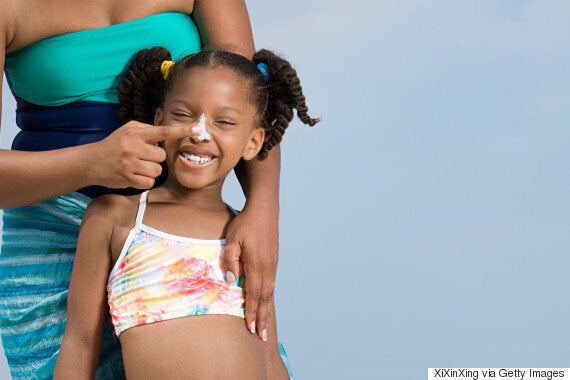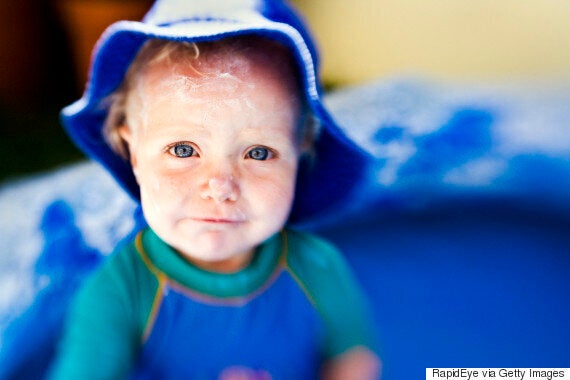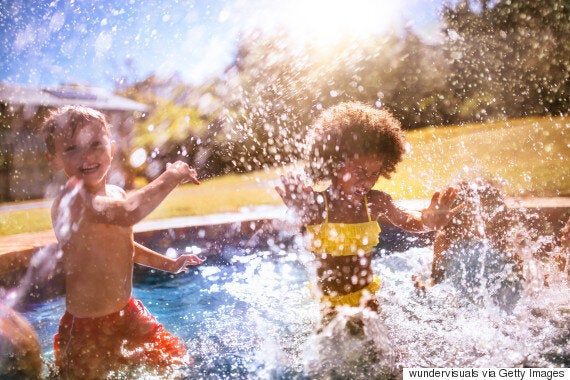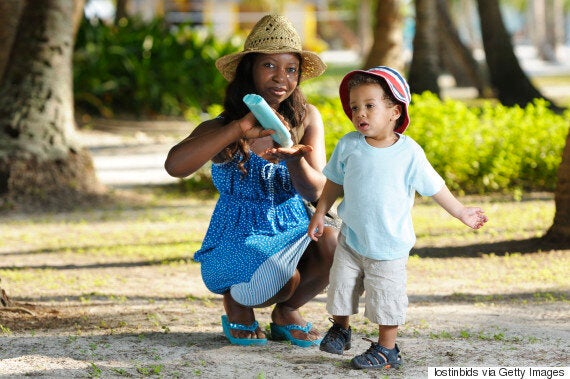Warmer weather brings a lot of wonderful things, but it also brings worries about sun protection — especially if you're responsible for keeping kids free of burns.
And make no mistake, that burn protection is important. "Five bad sunburns can increase your odds of developing skin cancer by 80 per cent,” Sage Singleton of SafeWise tells HuffPost Canada. "Sunscreen is essential, but if you don't use it properly, you're still at risk for sun damage."
Facing the sunscreen aisle, with its assortment of formulas, SPFs, ingredients, and prices, can be dizzying. But our expert advice will help you make the best sun protection choices for your kids.

Try to test it first: If you have time before the sun season begins, test your chosen sunscreen on a small patch of your child’s skin to test for reactions, recommends Dr. Alison Mitzner, a paediatrician and mom of two. "If you see any rash, try a different product,” Mitzner tells HuffPost Canada. "Also, it is important to look at the ingredients and discuss with your pediatrician to review what ingredients you should avoid for your child in the future."
Apply evenly and be generous: Many people apply and reapply sunscreen religiously, but don’t put on enough for it to be properly effective. "SPF is based on a specific amount of sunscreen during testing. If you are applying less, you have less sun protection," says Paula Mendonça, owner of SeaBerry Studios, which sells natural skincare products and hosts workshops in St. John's, Newfoundland. "There's no set amount for children but the Skin Cancer Foundation recommends that adults use at least an ounce (30 ml) of sunscreen."
Smear it on early: Put your sunscreen on 30 minutes before you go out in the sun, Singleton says, in order to give it time to dry properly and be as effective as possible. If you are using sunblock that requires absorption to work, this time is particularly important, Mitzner says. Titanium dioxide and zinc oxide are effective right away because they are physical sun blockers, not chemical ones.

Chemical or physical blockers?: Sunscreens can contain chemical blockers, physical blockers, or a combination of the two. "Chemical filters absorb some of the UVA and UVB radiation. These include avobenzone, homosalate oxybenzone, octisalate, octocrylene and octinoxate," Mendonça explains. "Physical filters scatter and reflect UVB and UVA radiation. These include zinc oxide and titanium dioxide." Some people have concerns about chemical blockers because of potential reactions or hormone-mimicking in some ingredients, but both chemical and physical blockers can be effective.
Go with SPF 45 as a default: Not sure which strength to pick? Singleton suggests going with SPF 45, which she says will protect against 98 per cent of the sun’s harmful rays. "Higher SPFs don't add protection and lower SPFs don't give adequate protection,” she says.
More about sunscreen
• The Top-Rated Sunscreens For Kids (That You Can Actually Get In Canada)
Block UVA and UVB: "The sun produces UVB and UVA rays," Mendonça explains. "The UVB have shorter wavelengths that affect the surface of the skin and can cause sunburns and skin cancer. The UVA have longer wavelengths that penetrate deeper in the skin and while they do not cause sunburns it can cause cellular damage, aging and skin cancer." SPF only refers to the protection from UVB rays so read labels to ensure you're getting a broad-spectrum or full-spectrum sunscreen that protects against both UVA and UVB rays with a chemical blocker, a physical blocker, or a combination of both.
Waterproof comes with conditions: No sunscreen is truly waterproof — as in, it won’t wash off after time in a pool, lake, or ocean. "Sunscreen will eventually wear off due to water exposure, sweat or time,” Singleton says. “Water-resistant sunscreen stays on longer in water, but will need to be re-applied after 40-80 minutes."

Reconsider spray sunscreens: Mitzner recommends against spray sunscreens altogether because they can be inhaled. “If they are needed to be used, the best way to apply is to put it on your hands and then apply to your skin and use caution near eyes and mouth,” she says. "This is because of concerns of inhalation of the product.” And try to use sprays outdoors, or in well-ventilated areas.
Don’t buy sunscreen/bug spray combos: Sunscreen needs to be reapplied frequently, Mitzner says, but bug repellent often does not. You could end up using a lot more repellent on your kids than you’d like if you get one that’s combined with sunscreen — or applying your sunscreen far less often than you ought to.
Reapply, reapply, reapply: Reapply after your child gets out of the water. Reapply if your child sweats a lot. Reapply every two hours on top of that. Don’t just put on sunscreen in the morning and think you’re set all day — you aren’t!

Avoid the strongest hours of sun: The hours between 10 a.m. and 3 p.m. have the strongest rays, Singleton says, and it’s best to either avoid the sun then or double up by using sunscreen and wearing clothing that protects your skin. And add a hat and sunglasses as well, Mitzner says, to protect your eyes and prevent heat stroke.
Avoid sun for babies: "Infants younger than six months should stay out of the sun as much as possible,” Mitzner says. "If outside, ensure they are kept in the shade and have a hat and sunglasses and other sun-protective clothing.” Sunscreen isn’t recommended for infants younger than six months old, she says; their thinner skin absorbs ingredients more readily than an adult’s, and sunscreen can irritate an infant’s sensitive skin.
Expert favourites: Mitzner recommends Beautycounter sunscreens for the whole family, and likes Babyganics’ mineral-based sunscreens for children. "I adore the Badger Kids Sunscreen Cream, made with certified natural ingredients,” says Pratibha Vuppuluri, CEO of Get Me Charlie. "It uses zinc oxide as a blocker and sunflower oil as its base for easy application."